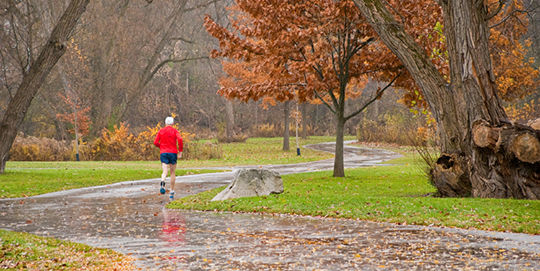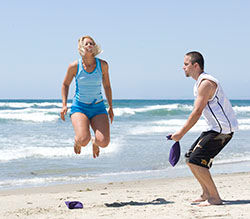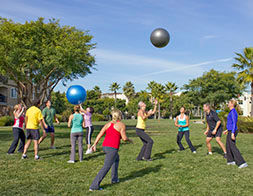
By Mark P. Kelly, Ph.D.
Do you find that many of your clients are inclined to ditch their usual workouts this time of year, especially if they prefer to train outdoors? After all, people throughout the county are digging out of snow drifts and bundling up to avoid the icy burn that comes with frigid temperatures. The same could be said for spring, when unpredictable weather and constant rain showers offer a ready excuse to stay home. And what about those soaring temperatures in summer and early fall?
The fact is, seasonal weather changes can make it difficult for clients to stick with their training programs. That is, unless their trainers learn how to adapt and develop programs that take into account variable weather while also keeping clients engaged and motivated. Rather than bemoaning the change of seasons, here are some helpful ways to “go with the flow” of nature by periodizing your clients’ workouts accordingly.
Periodization 101
Designing a program around nature requires a solid understanding of periodization, which is simply altering the components of a program to optimize the performance on a given date. There are numerous factors that must be accounted for when periodizing a program for a particular athlete in a particular sport at a particular time. Here is a quick overview.
While there is some variability in the methods for periodizing programs, most experts agree that the four basic components are: base, sharpening, peak and taper. Some sources also break it into a yearly cycle of preparatory phase, competitive phase and transition phase. No matter how you slice up the phases, it is essentially a building up of the endurance and foundational strength, before moving into more speed and power, which may then transition into ballistic training in some power-based sports and interval training in endurance sports. The final phase is geared toward recovery so the training effects can be fully realized and the mind and body are at their maximum capabilities.
Traditional periodized training typically revolves around a specific competition or perhaps playoff season time. Some athletes, such as those who train for the Olympics, adopt a four-year plan, while other athletes focus on peaking at certain times of the year. For the purposes of this article, we will demonstrate how to periodize a yearly program for a client who wants to peak (aesthetically or performance-wise) during the summer (a common goal for many pool or beach goers). Additionally, the ACE Integrated Fitness Training® (ACE-IFT®) Model will be referenced and shown in parentheses throughout this article.

 During the winter it gets cold and dark early. Fortunately, there are some fun holidays and winter sports to keep things interesting. If you live in a Southern state in the U.S., you are likely able to continue to train clients outdoors at certain times and can urge your clients to take advantage of the cool months by training for longer-distance events such as half and full marathons. For those in cooler climes, gym-based cardio equipment, such as the treadmill and elliptical, is ideal for this type of training. You can help your clients maximize their indoor training efforts in the winter by building up their mileage throughout the fall.
During the winter it gets cold and dark early. Fortunately, there are some fun holidays and winter sports to keep things interesting. If you live in a Southern state in the U.S., you are likely able to continue to train clients outdoors at certain times and can urge your clients to take advantage of the cool months by training for longer-distance events such as half and full marathons. For those in cooler climes, gym-based cardio equipment, such as the treadmill and elliptical, is ideal for this type of training. You can help your clients maximize their indoor training efforts in the winter by building up their mileage throughout the fall.
If you are training experienced resistance athletes, have them do some heavier lifting with fewer repetitions. Winter sports such as ice skating, hockey, skiing and snowboarding all require a decent amount of leg power, so make sure not to skimp on the lower-body lifting for clients who enjoy these pursuits. Urge your beginning exercise clients to try a new type of indoor class, such as yoga or Pilates, both of which will increase joint stability and mobility (Phase 1) and increase overall flexibility and movement efficiency (Phase 2). These efforts will all serve as ideal preparation for greater movement efficiency come spring.

 The transition from winter to spring can be a joy to those in the Northern states who have been bound up indoors. For allergy sufferers, however, it can be misery. The days are getting longer and warmer, but you may want to consider altering your clients’ training so that workouts are actually shorter and more intense. If you were previously training a client longer and slower [e.g., 40–90 minutes at 55–75% of maximum heart rate (Zones 1 and 2)], you may want to ratchet down the duration to 30 to 60 minutes, but increase the intensity to 65 to 85% of maximum heart rate (Zones 2 and 3). The higher intensity should both increase your client’s aerobic power and shed some of those stubborn winter pounds that may still be lingering.
The transition from winter to spring can be a joy to those in the Northern states who have been bound up indoors. For allergy sufferers, however, it can be misery. The days are getting longer and warmer, but you may want to consider altering your clients’ training so that workouts are actually shorter and more intense. If you were previously training a client longer and slower [e.g., 40–90 minutes at 55–75% of maximum heart rate (Zones 1 and 2)], you may want to ratchet down the duration to 30 to 60 minutes, but increase the intensity to 65 to 85% of maximum heart rate (Zones 2 and 3). The higher intensity should both increase your client’s aerobic power and shed some of those stubborn winter pounds that may still be lingering.
For resistance training, you may opt to gear down the intensity (weight) and increase repetitions if your client was previously focusing on heavy lifting during the winter. Alternatively, a client might want to work up to load training, particularly if he or she has been working on stability/mobility and movement-type training. Either way, incorporating a lot of functional exercises and workouts using body weight and resistances geared toward higher repetitions (eight to 16) and lower resistances [60 to 85% of one-repetition maximum (1-RM)]. This also is a good time to urge your clients to try a new fun-focused class at the gym or to consider training for a mud run or obstacle course race.

 Summer is the time when most clients want to peak. Again, depending on where you live, this may be one of the few times of year you can actually train your clients outside. In other areas, however, the heat and humidity can be so suppressing that it becomes depressing and starts regressing your clients’ training. Don’t hesitate to take your clients’ workouts indoors, if necessary. Whenever possible, schedule trainings in the early mornings or later evenings and focus on activities like swimming or cycling where the environment (water or wind, respectively) may help you keep clients cool. Sun protection—for both you and your clients—is a must, and you need to keep things short and sweet. This is the time of year to do some high-intensity interval training (HIIT) or metabolic training. Use the rest intervals to allow your client to cool down and hydrate up. Remind your clients that the heat will likely shorten the duration of their workouts, so they should focus instead on increasing their intensity and working hard.
Summer is the time when most clients want to peak. Again, depending on where you live, this may be one of the few times of year you can actually train your clients outside. In other areas, however, the heat and humidity can be so suppressing that it becomes depressing and starts regressing your clients’ training. Don’t hesitate to take your clients’ workouts indoors, if necessary. Whenever possible, schedule trainings in the early mornings or later evenings and focus on activities like swimming or cycling where the environment (water or wind, respectively) may help you keep clients cool. Sun protection—for both you and your clients—is a must, and you need to keep things short and sweet. This is the time of year to do some high-intensity interval training (HIIT) or metabolic training. Use the rest intervals to allow your client to cool down and hydrate up. Remind your clients that the heat will likely shorten the duration of their workouts, so they should focus instead on increasing their intensity and working hard.
At this time of year, resistance training can vary greatly depending on the goals of the client. For example, you can maximize your client’s hypertrophy and power with high-intensity, short-rest-interval training. Conversely, you may recommend a lot of body-weight, muscular endurance−type training. Consider creating your own outdoor circuit workout or utilizing playgrounds and other recreational spaces to develop fun and creative workouts. Metabolic training is ideal for clients who want to maximize their training time by performing both cardio and resistance exercise in every workout.
![]()


Some clients feel that, come fall, their bodies are ready for a break from higher-intensity activities. If you reside in a hot weather area, you and your clients likely need a break from the heat. Unless your clients have some major competitions at this time of year, urge them to pull back on the reins a little and enjoy some “playtime.” Urge your clients to try a new sport or play athletic games like disc golf, Ultimate (sometimes referred to as Ultimate Frisbee) or Smashball, or perhaps revisit old favorites like tennis, racquetball, softball or soccer. This is the time of year to focus on having fun and to reevaluate one’s goals for the coming seasons. Use this opportunity to determine your endurance-focused clients’ heart-rate training values for different distances and start increasing their distances for a fall event.
There are as many different fitness or athletic goals as there are clients, and you will have to adjust your timelines and training accordingly. Adjusting to seasonal fluctuations is a great way keep clients progressing toward their goals by keeping things fresh and maximizing the benefits (while also minimizing the drawbacks) of each season. Be sure to help your clients identify some concrete goals (e.g., competitions, weight loss, improved overall endurance) that can serve as guideposts throughout the year to help them maintain their focus. And finally, remember to go with the flow of the seasons and help your clients to stop making excuses and instead find their personal niches in often fast-changing environments.
___________________________________________________________________________
 Mark P. Kelly, Ph.D., CSCS is an exercise physiologist for the American Council on Exercise. He has been involved in exercise sciences as an author, presenter, trainer and athlete for more than 25 years. He has been teaching sciences in universities, and performing research and physiological assessments in exercise science for more than 20 years. He has had his scientific studies published by the ACSM, NSCA and FASEB, and currently produces workshops, webinars, books and articles to bridge the gap between science and application for trainers and the general public.
Mark P. Kelly, Ph.D., CSCS is an exercise physiologist for the American Council on Exercise. He has been involved in exercise sciences as an author, presenter, trainer and athlete for more than 25 years. He has been teaching sciences in universities, and performing research and physiological assessments in exercise science for more than 20 years. He has had his scientific studies published by the ACSM, NSCA and FASEB, and currently produces workshops, webinars, books and articles to bridge the gap between science and application for trainers and the general public.